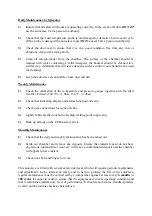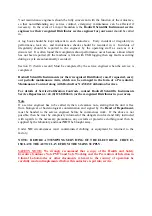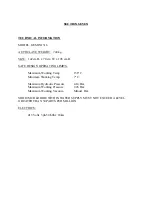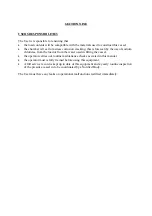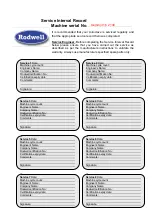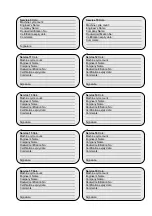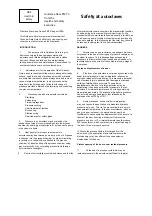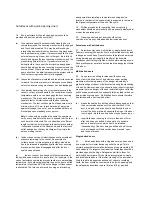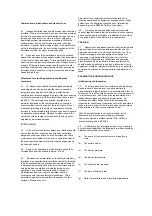
Common drain, blown-down and transfer lines
24 Independent drain lines and blow-down lines should be
provided. If this is not practicable, devices should be provided
to ensure that only one autoclave blow-down valve can be in
the open position at any one time, in order to safeguard
against inadvertent pressurisation or scalding. Where the
exhaust steam from one autoclave is re-used in another
autoclave, it is essential to provide a valve in the transfer line,
which is interlocked with the door locking mechanism of the
autoclave to which the steam is being supplied.
25 No person should be permitted to enter the confined
space of an autoclave unless an assessment has been made
of the risks to health and safety. This is particularly important
when fumes or an inert atmosphere such as nitrogen may be
present. Following the assessment a safe system of work
should be drawn up and implemented. Persons entering an
autoclave should use a key or tag to prevent the door being
closed behind them.
Autoclaves for sterilizing liquids in sealed glass
containers
26
To reduce the possibility of sealed glass containers
exploding when an autoclave sterilizer door is opened, a
temperature sensing device should be provided which
controls a door interlock arranged to prevent the door opening
until the temperature in all the containers has fallen to less
than 80
0
C
.
The sensing device may be inserted into a
simulator, designed so that its temperature on cooling is
never less than that of any part of the load. Where it is not
reasonably practicable to provide a temperature sensitive
interlock, a time activated interlock may be used set to ensure
an adequate cooling period. Whatever method is used, the
controls should be tamper-proof and should only be set or
adjusted by authorised persons.
INTERLOCKING
27
In the context of autoclave safety, any interlock should
ensure that the door cannot be opened when potentially
dangerous conditions exist within the autoclave and that a
cycle cannot be initiated until the door is completely closed,
the securing mechanism is fully and correctly engaged and
the chamber sealed.
28 Some of the situations in which interlocks should be
provided have been described in paras 18 to 26.
29
Because an operator relies on the safety afforded by
interlocks it is essential that all interlocks should fail to safety.
It is also essential that the interlock devices are sufficiently
robust and securely attached to the autoclave prevent them
being distorted, overridden, or defeated during normal
operation. They should function reliably, be properly
maintained and be kept correctly adjusted, strictly in
accordance with the manufacturers instructions. This is
particularly important where safety is dependent on limit
switches. If these are out of
Adjustment they could allow premature operation of a
following sequence with dangerous consequences. Useful
guidance on the principles of application of interlocking
devices is given in BS5304:
Safety of machinery.
30
A properly trained and authorised person should
check at regular intervals that the interlocks function correctly
and cannot be easily overridden or defeated; this should be
done at least daily if the autoclave is in constant use.
TRAINING
31
Operators of autoclaves should be fully instructed and
properly trained in correct operating procedures and the
purpose and function of controls and safety devices. They
and their managers should be aware of the dangers of
by-passing or interfering with safety devices or of other
malpractices. Manufacturers' instructions and operating
procedures should be readily available to operators and
should always be adhered to and any malfunction or faulty
equipment should be reported without delay to an appointed
superior who will ensure that appropriate remedial action is
taken.
EXAMINATION AND MAINTENANCE
Initial testing and inspection
32
An initial pressure test in accordance with the design
standard should be carried out on each autoclave to
demonstrate its integrity as far as it is possible with a test of
this nature. This test should be carried out in the presence of
a competent person, who may be the representative of an
independent engineering inspection organisation. All
interlocks and safety devices should be assessed and
inspected for correctness of operation before the autoclave is
taken into use. A report of the test and inspection should be
made available to the user and retained by him.
Note:
Pneumatic testing is not recommended, as it is
hazardous and requires special safety precautions.
Advice is contained in Guidance Note GS4 -
Safety in
pressure testing
and in BS 5500.
33
In addition to any information which may be required
by the relevant legislation, the following information should be
permanently marked on the vessel:-
(a)
The name of the manufacturer or his identifying
mark.
(b)
The serial number
(c)
The design pressure
(d)
The design temperature
(e)
The hydraulic test pressure
(f)
The date of hydraulic test
(g)
Date of manufacture and manufacturing standard.

